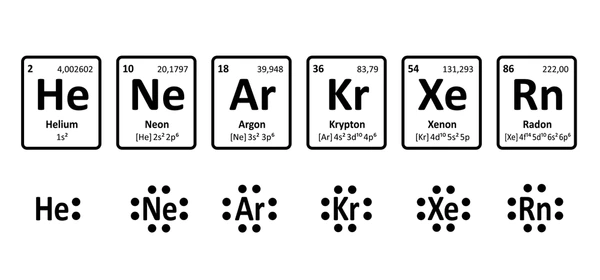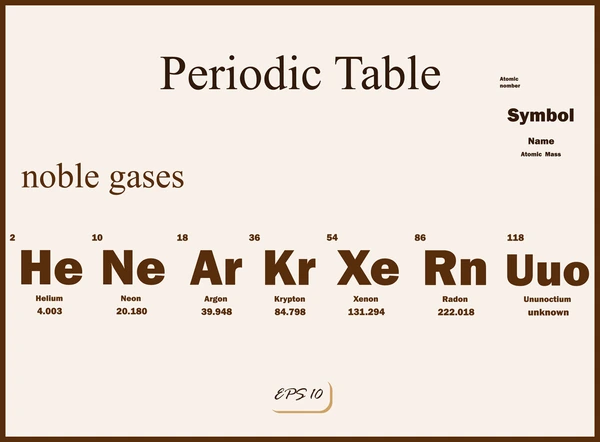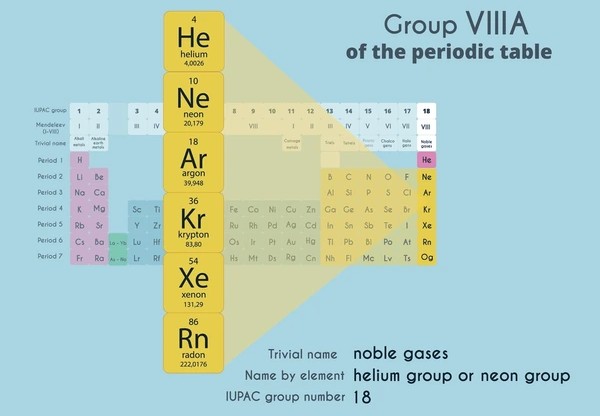Noble gases, also known as inert gases, belong to Group 18 of the periodic table. They are renowned for their remarkable chemical stability, which stems from their filled valence electron shells. This group comprises helium (He), neon (Ne), argon (Ar), krypton (Kr), xenon (Xe), and the radioactive element radon (Rn). Although they were once believed to be entirely unreactive, these gases have demonstrated significant importance in numerous scientific, industrial, and medical applications.
Electronic Configuration and Chemical Stability
What sets noble gases apart is their filled outermost electron shells, resulting in minimal chemical reactivity. For instance:
- Helium: 1s²
- Neon: 1s² 2s² 2p⁶
- Argon: [Ne] 3s² 3p⁶
- Krypton: [Ar] 3d¹⁰ 4s² 4p⁶
- Xenon: [Kr] 4d¹⁰ 5s² 5p⁶
- Radon: [Xe] 4f¹⁴ 5d¹⁰ 6s² 6p⁶
Because of this stable configuration, noble gases have high ionization energies, low electron affinities, and negligible electronegativity, making them unreactive under normal conditions.
Physical Properties of Noble Gases

All noble gases are colorless, odorless, and tasteless in their natural state. They are non-flammable and monatomic gases under standard conditions. Here are some distinctive physical features:
- Low boiling and melting points
- Poor conductors of electricity and heat
- High thermal conductivity (especially helium)
- Insolubility in water
The density and boiling points increase progressively down the group, making radon the heaviest and most radioactive of them all.
Sources and Extraction of Noble Gases
Most noble gases are extracted from air using fractional distillation of liquefied air. Helium, however, is obtained from natural gas deposits rich in helium. Here’s a breakdown:
- Helium: Natural gas fields, especially in the USA and Qatar
- Neon, Argon, Krypton, Xenon: Fractional distillation of liquefied air
- Radon: By-product of radioactive decay of uranium and thorium
The abundance of noble gases in Earth’s atmosphere is dominated by argon (~0.93%), followed by neon, helium, and trace amounts of krypton and xenon.
Industrial and Scientific Applications of Noble Gases

Despite their chemical inertness, noble gases have found widespread utility in modern technology and research due to their physical properties.
1. Helium: The Lightest and Most Versatile Noble Gas
- Cryogenics: Used to cool superconducting magnets in MRI machines
- Aerospace: Fills weather balloons and airships due to their low density
- Welding: Acts as a shielding gas in arc welding
- Semiconductors: Used in clean room environments
2. Neon: Lighting the World
- Advertising signs: Its bright red-orange glow is iconic in neon signs
- High-voltage indicators and vacuum tubes
- Cryogenic refrigeration
3. Argon: The Shielding Champion
- Welding industry: Provides an inert atmosphere for metal fabrication
- Incandescent and fluorescent lighting
- Preservation: Used in wine bottling and museum displays to protect artifacts
4. Krypton and Xenon: Lighting and Medical Imaging
- Xenon flash lamps and strobe lights
- High-performance lighting systems
- Anesthetic: Xenon is being researched as a noble gas anesthetic
- Medical imaging: Xenon isotopes assist in lung imaging
5. Radon: From Hazards to Medical Use
- Radioactive gas found in uranium-rich soils
- Carcinogenic when accumulated in enclosed spaces
- Previously used in radiation therapy for cancer treatment
Environmental and Health Concerns
Although most noble gases are non-toxic, radon stands out as a significant health hazard due to its radioactivity. Extended exposure to elevated radon concentrations is a leading cause of lung cancer, highlighting the importance of radon detectors and adequate ventilation in structures, particularly basements.
Noble Gases and the Atmosphere
Noble gases make up a small but crucial component of the Earth’s atmosphere:
- Argon (Ar): ~0.93% of atmospheric gases
- Neon, Helium, Krypton, Xenon: Present in trace amounts
Unlike carbon dioxide or methane, these gases do not react with other atmospheric components and play a passive role in climate change.
Scientific Discoveries and Historical Context
The discovery of noble gases began in the late 19th century:
- 1868: Helium was discovered in the sun’s spectrum by Janssen and Lockyer
- 1894: Argon was isolated by Lord Rayleigh and William Ramsay
- 1898-1900: Neon, krypton, and xenon were discovered by Ramsay and Morris Travers
- 1900: Radon was discovered by Friedrich Dorn
These discoveries reshaped the periodic table, leading to the formation of a new group, Group 18, and enhancing our understanding of atomic structure.
Chemical Reactions of Noble Gases

Though once believed to be completely inert, noble gas compounds have been synthesized, particularly with xenon and krypton. Examples include:
- Xenon hexafluoroplatinate (XePtF₆)
- Xenon tetrafluoride (XeF₄)
- Krypton difluoride (KrF₂)
These compounds are formed under extreme conditions, showcasing that even the most stable elements can participate in chemical bonding when properly manipulated.
Safety and Environmental Impact
Are Noble Gases Dangerous?
Most noble gases are non-toxic and safe. However, radon is a notable exception due to its radioactive nature.
Sustainability and Extraction
Helium is non-renewable and is facing a global shortage. Most noble gases are collected through air liquefaction and separation.
Future Prospects of Noble Gases
The field of noble gas chemistry is rapidly evolving, with discoveries emerging in medicine, materials science, and space exploration. Their inert properties, coupled with physical versatility, make noble gases ideal for developing advanced technologies. Future applications may include:
- Plasma propulsion systems
- Noble gas lasers
- Quantum computing environments
- Eco-friendly lighting systems
Conclusion: Silent, Invisible, Yet Indispensable
Despite being invisible and odorless, noble gases are indispensable to modern life. From lighting up cities to powering life-saving medical machines, their role continues to expand. Understanding and harnessing their unique properties will undoubtedly pave the way for innovative breakthroughs in science and industry.
Why are noble gases unreactive?
Can noble gases form compounds?
What is the most common noble gas on Earth?
Is radon harmful?
Where is helium found naturally?
What happens if we run out of helium?
What are Noble gases?
Noble gases, also known as inert gases, belong to Group 18 of the periodic table. They are renowned for their remarkable chemical stability, which stems from their filled valence electron shells. This group comprises helium (He), neon (Ne), argon (Ar), krypton (Kr), xenon (Xe), and the radioactive element radon (Rn). Although they were once believed to be entirely unreactive, these gases have demonstrated significant importance in numerous scientific, industrial, and medical applications.
Electronic Configuration and Chemical Stability
What sets noble gases apart is their filled outermost electron shells, resulting in minimal chemical reactivity. For instance:
Helium: 1s²
Neon: 1s² 2s² 2p⁶
Argon: [Ne] 3s² 3p⁶
Krypton: [Ar] 3d¹⁰ 4s² 4p⁶
Xenon: [Kr] 4d¹⁰ 5s² 5p⁶
Radon: [Xe] 4f¹⁴ 5d¹⁰ 6s² 6p⁶
Because of this stable configuration, noble gases have high ionization energies, low electron affinities, and negligible electronegativity, making them unreactive under normal conditions.
Physical Properties of Noble Gases

All noble gases are colorless, odorless, and tasteless in their natural state. They are non-flammable and monatomic gases under standard conditions. Here are some distinctive physical features:
Low boiling and melting points
Poor conductors of electricity and heat
High thermal conductivity (especially helium)
Insolubility in water
The density and boiling points increase progressively down the group, making radon the heaviest and most radioactive of them all.
Sources and Extraction of Noble Gases
Most noble gases are extracted from air using fractional distillation of liquefied air. Helium, however, is obtained from natural gas deposits rich in helium. Here’s a breakdown:
Helium: Natural gas fields, especially in the USA and Qatar
Neon, Argon, Krypton, Xenon: Fractional distillation of liquefied air
Radon: By-product of radioactive decay of uranium and thorium
The abundance of noble gases in Earth’s atmosphere is dominated by argon (~0.93%), followed by neon, helium, and trace amounts of krypton and xenon.
Industrial and Scientific Applications of Noble Gases

Despite their chemical inertness, noble gases have found widespread utility in modern technology and research due to their physical properties.
1. Helium: The Lightest and Most Versatile Noble Gas
Cryogenics: Used to cool superconducting magnets in MRI machines
Aerospace: Fills weather balloons and airships due to their low density
Welding: Acts as a shielding gas in arc welding
Semiconductors: Used in clean room environments
2. Neon: Lighting the World
Advertising signs: Its bright red-orange glow is iconic in neon signs
High-voltage indicators and vacuum tubes
Cryogenic refrigeration
3. Argon: The Shielding Champion
Welding industry: Provides an inert atmosphere for metal fabrication
Incandescent and fluorescent lighting
Preservation: Used in wine bottling and museum displays to protect artifacts
4. Krypton and Xenon: Lighting and Medical Imaging
Xenon flash lamps and strobe lights
High-performance lighting systems
Anesthetic: Xenon is being researched as a noble gas anesthetic
Medical imaging: Xenon isotopes assist in lung imaging
5. Radon: From Hazards to Medical Use
Radioactive gas found in uranium-rich soils
Carcinogenic when accumulated in enclosed spaces
Previously used in radiation therapy for cancer treatment
Environmental and Health Concerns
Although most noble gases are non-toxic, radon stands out as a significant health hazard due to its radioactivity. Extended exposure to elevated radon concentrations is a leading cause of lung cancer, highlighting the importance of radon detectors and adequate ventilation in structures, particularly basements.
Noble Gases and the Atmosphere
Noble gases make up a small but crucial component of the Earth’s atmosphere:
Argon (Ar): ~0.93% of atmospheric gases
Neon, Helium, Krypton, Xenon: Present in trace amounts
Unlike carbon dioxide or methane, these gases do not react with other atmospheric components and play a passive role in climate change.
Scientific Discoveries and Historical Context
The discovery of noble gases began in the late 19th century:
1868: Helium was discovered in the sun’s spectrum by Janssen and Lockyer
1894: Argon was isolated by Lord Rayleigh and William Ramsay
1898-1900: Neon, krypton, and xenon were discovered by Ramsay and Morris Travers
1900: Radon was discovered by Friedrich Dorn
These discoveries reshaped the periodic table, leading to the formation of a new group, Group 18, and enhancing our understanding of atomic structure.
Chemical Reactions of Noble Gases

Though once believed to be completely inert, noble gas compounds have been synthesized, particularly with xenon and krypton. Examples include:
Xenon hexafluoroplatinate (XePtF₆)
Xenon tetrafluoride (XeF₄)
Krypton difluoride (KrF₂)
These compounds are formed under extreme conditions, showcasing that even the most stable elements can participate in chemical bonding when properly manipulated.
Safety and Environmental Impact
Are Noble Gases Dangerous?
Most noble gases are non-toxic and safe. However, radon is a notable exception due to its radioactive nature.
Sustainability and Extraction
Helium is non-renewable and is facing a global shortage. Most noble gases are collected through air liquefaction and separation.
Future Prospects of Noble Gases
The field of noble gas chemistry is rapidly evolving, with discoveries emerging in medicine, materials science, and space exploration. Their inert properties, coupled with physical versatility, make noble gases ideal for developing advanced technologies. Future applications may include:
Plasma propulsion systems
Noble gas lasers
Quantum computing environments
Eco-friendly lighting systems
Conclusion: Silent, Invisible, Yet Indispensable
Despite being invisible and odorless, noble gases are indispensable to modern life. From lighting up cities to powering life-saving medical machines, their role continues to expand. Understanding and harnessing their unique properties will undoubtedly pave the way for innovative breakthroughs in science and industry.
What is a noble gas, and what are its properties?
Noble gases, also known as inert gases, belong to Group 18 of the periodic table. They are renowned for their remarkable chemical stability, which stems from their filled valence electron shells. This group comprises helium (He), neon (Ne), argon (Ar), krypton (Kr), xenon (Xe), and the radioactive element radon (Rn). Although they were once believed to be entirely unreactive, these gases have demonstrated significant importance in numerous scientific, industrial, and medical applications.
Electronic Configuration and Chemical Stability
What sets noble gases apart is their filled outermost electron shells, resulting in minimal chemical reactivity. For instance:
Helium: 1s²
Neon: 1s² 2s² 2p⁶
Argon: [Ne] 3s² 3p⁶
Krypton: [Ar] 3d¹⁰ 4s² 4p⁶
Xenon: [Kr] 4d¹⁰ 5s² 5p⁶
Radon: [Xe] 4f¹⁴ 5d¹⁰ 6s² 6p⁶
Because of this stable configuration, noble gases have high ionization energies, low electron affinities, and negligible electronegativity, making them unreactive under normal conditions.
Physical Properties of Noble Gases

All noble gases are colorless, odorless, and tasteless in their natural state. They are non-flammable and monatomic gases under standard conditions. Here are some distinctive physical features:
Low boiling and melting points
Poor conductors of electricity and heat
High thermal conductivity (especially helium)
Insolubility in water
The density and boiling points increase progressively down the group, making radon the heaviest and most radioactive of them all.
Sources and Extraction of Noble Gases
Most noble gases are extracted from air using fractional distillation of liquefied air. Helium, however, is obtained from natural gas deposits rich in helium. Here’s a breakdown:
Helium: Natural gas fields, especially in the USA and Qatar
Neon, Argon, Krypton, Xenon: Fractional distillation of liquefied air
Radon: By-product of radioactive decay of uranium and thorium
The abundance of noble gases in Earth’s atmosphere is dominated by argon (~0.93%), followed by neon, helium, and trace amounts of krypton and xenon.
Industrial and Scientific Applications of Noble Gases

Despite their chemical inertness, noble gases have found widespread utility in modern technology and research due to their physical properties.
1. Helium: The Lightest and Most Versatile Noble Gas
Cryogenics: Used to cool superconducting magnets in MRI machines
Aerospace: Fills weather balloons and airships due to their low density
Welding: Acts as a shielding gas in arc welding
Semiconductors: Used in clean room environments
2. Neon: Lighting the World
Advertising signs: Its bright red-orange glow is iconic in neon signs
High-voltage indicators and vacuum tubes
Cryogenic refrigeration
3. Argon: The Shielding Champion
Welding industry: Provides an inert atmosphere for metal fabrication
Incandescent and fluorescent lighting
Preservation: Used in wine bottling and museum displays to protect artifacts
4. Krypton and Xenon: Lighting and Medical Imaging
Xenon flash lamps and strobe lights
High-performance lighting systems
Anesthetic: Xenon is being researched as a noble gas anesthetic
Medical imaging: Xenon isotopes assist in lung imaging
5. Radon: From Hazards to Medical Use
Radioactive gas found in uranium-rich soils
Carcinogenic when accumulated in enclosed spaces
Previously used in radiation therapy for cancer treatment
Environmental and Health Concerns
Although most noble gases are non-toxic, radon stands out as a significant health hazard due to its radioactivity. Extended exposure to elevated radon concentrations is a leading cause of lung cancer, highlighting the importance of radon detectors and adequate ventilation in structures, particularly basements.
Noble Gases and the Atmosphere
Noble gases make up a small but crucial component of the Earth’s atmosphere:
Argon (Ar): ~0.93% of atmospheric gases
Neon, Helium, Krypton, Xenon: Present in trace amounts
Unlike carbon dioxide or methane, these gases do not react with other atmospheric components and play a passive role in climate change.
Scientific Discoveries and Historical Context
The discovery of noble gases began in the late 19th century:
1868: Helium was discovered in the sun’s spectrum by Janssen and Lockyer
1894: Argon was isolated by Lord Rayleigh and William Ramsay
1898-1900: Neon, krypton, and xenon were discovered by Ramsay and Morris Travers
1900: Radon was discovered by Friedrich Dorn
These discoveries reshaped the periodic table, leading to the formation of a new group, Group 18, and enhancing our understanding of atomic structure.
Chemical Reactions of Noble Gases

Though once believed to be completely inert, noble gas compounds have been synthesized, particularly with xenon and krypton. Examples include:
Xenon hexafluoroplatinate (XePtF₆)
Xenon tetrafluoride (XeF₄)
Krypton difluoride (KrF₂)
These compounds are formed under extreme conditions, showcasing that even the most stable elements can participate in chemical bonding when properly manipulated.
Safety and Environmental Impact
Are Noble Gases Dangerous?
Most noble gases are non-toxic and safe. However, radon is a notable exception due to its radioactive nature.
Sustainability and Extraction
Helium is non-renewable and is facing a global shortage. Most noble gases are collected through air liquefaction and separation.
Future Prospects of Noble Gases
The field of noble gas chemistry is rapidly evolving, with discoveries emerging in medicine, materials science, and space exploration. Their inert properties, coupled with physical versatility, make noble gases ideal for developing advanced technologies. Future applications may include:
Plasma propulsion systems
Noble gas lasers
Quantum computing environments
Eco-friendly lighting systems
Conclusion: Silent, Invisible, Yet Indispensable
Despite being invisible and odorless, noble gases are indispensable to modern life. From lighting up cities to powering life-saving medical machines, their role continues to expand. Understanding and harnessing their unique properties will undoubtedly pave the way for innovative breakthroughs in science and industry.
